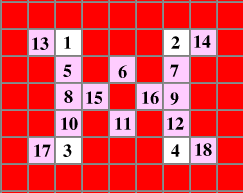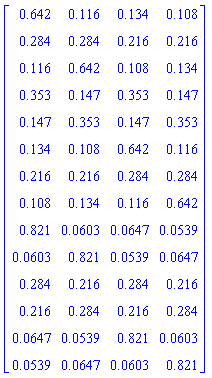Gen. 1
 | Gen. 2 |
|
Gen. 3 is a rotated version of Gen 1.
Gen. 4 is a rotated version of Gen 2. ( rotation 90°) | |
IS-osc.

Monogram has 4 stator cells and 14 rotor cells. The numbering is explained in the cycle matrix discussion.
| Cycle matrix | Det = 0 |
|
A closer look at the cycle matrix reveals that the rotor cells 5-12 form a communicating set (each cell in the set contributes to the colouring of any other cell in the set.) The cells 13-18 however do not belong to any commutating set (except their singletons), since they do not affect any other set. The cells 15 and 16 can be called sterile since they never get any offspring. (This is reflected in their 0-columns). The cells 13,14,17,18 (the 4 corner cells) get offspring (in the third generation) but their impact is restricted to the cells in the corner positions in the fifth generation , i.e. to themselves. (This is also visible in the columns: nonzero components only in the diagonal positions). The above properties explain the chosen numbering. |
|
|
Limit matrix
Greyscale discussion in new window |
|||||
Here below is the G* part of the limit matrix in rational and floating form.
| |||||

